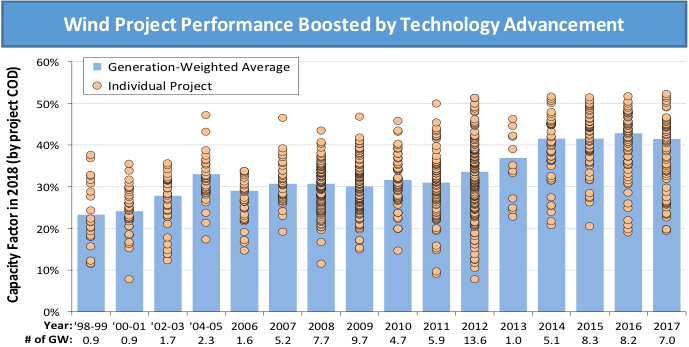Wind energy pricing remains attractive, according to a report released by the U.S. Department of Energy and prepared by Lawrence Berkeley National Laboratory (Berkeley Lab). With prices averaging below 2 cents per kilowatt-hour (kWh) for newly built projects, wind is competitive with other generation sources.
“Wind energy prices – particularly in the central United States, and supported by federal tax incentives – are at all-time lows, with utilities and corporate buyers selecting wind as a low-cost option,” said Berkeley Lab Senior Scientist Ryan Wiser.
Key findings from the U.S. Department of Energy’s “Wind Technologies Market Report” include:
- Wind power capacity additions continued at a robust pace in 2018. Nationwide, wind power capacity additions equaled 7,588 megawatts (MW) in 2018, with $11 billion invested in new plants. Wind power constituted 21% of all U.S. generation capacity additions. Wind energy contributed 6.5% of the nation’s electricity supply, more than 10% of total electricity generation in 14 states, and more than 30% in three of those states (Kansas, Iowa, and Oklahoma). Also, 232 gigawatts of wind are seeking transmission interconnection, 2% of which represents proposed wind plants paired with storage
- Bigger turbines are enhancing wind project performance. The average generating capacity of newly installed wind turbines in the United States in 2018 was 2.4 MW, up 239% since 1998-1999. The average rotor diameter was 116 meters, up 141% over 1998-1999, while the average hub height was 88 meters, up 57% since 1998-1999. Permit applications suggest that much-taller turbines are on the way. Increased rotor diameters, in particular, have boosted wind project capacity factors in recent years. The average 2018 capacity factor among projects built from 2014 through 2017 was 42%, compared to an average of 31% among projects built from 2004 to 2011, and 24% among projects built from 1998 to 2001.
- Low wind turbine pricing continues to push down installed project costs. Wind turbine equipment prices have fallen to $700-$900/kilowatt (kW), and these declines are pushing down project-level costs. The average installed cost of wind projects in 2018 was $1,470/kW, down 40% since the peak in 2009 and 2010.
- Wind energy prices are at historical lows. Lower installed project costs, along with improvements in capacity factors, are enabling aggressive wind power pricing. After topping out at 7 cents per kWh in 2009, the average levelized long-term price from wind power sales agreements has dropped to below 2 cents per kWh. Recently signed wind energy contracts compare favorably to projections of the fuel costs of gas-fired generation. Solar prices have also declined precipitously, pressuring wind’s competitiveness in some regions. The levelized cost of wind also hit an all-time low, averaging $36/MWh for plants built in 2018.
- The grid-system value of wind has declined over the last decade but rebounded over the last two years. The value of wind in wholesale power markets is impacted by the location of wind plants, their hourly output profiles, and how those characteristics correlate with real-time electricity prices and capacity markets. The market value of wind in 2018 was the lowest in the Southwest Power Pool and Texas (average of $17/MWh and $18/MWh, respectively) whereas the highest-value market was New England (at $41/MWh). Wind energy prices are generally competitive with these value estimates, spurring demand for wind from both traditional electric utilities and nonutility purchasers, such as corporations, universities, and municipalities.
- The domestic supply chain for wind equipment is diverse. For wind projects recently installed in the United States, domestically manufactured content is highest for nacelle assembly (more than 90%), towers (75 to 90%), and blades and hubs (50 to 70%). It is much lower (less than 20%) for most components internal to the nacelle. Wind sector employment reached a new high of 114,000 full-time workers at the end of 2018.
Berkeley Lab’s contributions to this report were funded by the U.S. Department of Energy’s Office of Energy Efficiency and Renewable Energy.
# # #
Founded in 1931 on the belief that the biggest scientific challenges are best addressed by teams, Lawrence Berkeley National Laboratory and its scientists have been recognized with 13 Nobel Prizes. Today, Berkeley Lab researchers develop sustainable energy and environmental solutions, create useful new materials, advance the frontiers of computing, and probe the mysteries of life, matter, and the universe. Scientists from around the world rely on the Lab’s facilities for their own discovery science. Berkeley Lab is a multiprogram national laboratory, managed by the University of California for the U.S. Department of Energy’s Office of Science.
DOE’s Office of Science is the single largest supporter of basic research in the physical sciences in the United States, and is working to address some of the most pressing challenges of our time. For more information, please visit energy.gov/science.
Additional Information:
The full 2018 Wind Technologies Market Report, a presentation slide deck that summarizes the report, several data visualizations, and an Excel workbook that contains much of the data presented in the report, can be downloaded from windreport.lbl.gov.
The U.S. Department of Energy’s release on this study is available at energy.gov/windreport.
Technical contacts:
Ryan Wiser (510) 486-5474, [email protected]
Mark Bolinger (603) 795-4937, [email protected]




